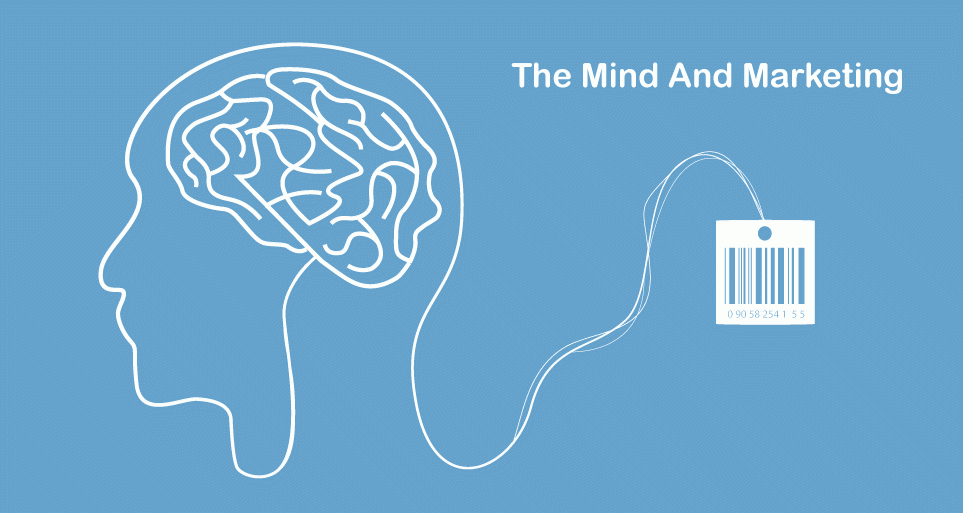The Psychology Behind Marketing
Posted on January 22, 2016
By Theresa Chiechi, Designer, Illustrator, Writer

Psychology, the study of the human mind and behavior, plays a big part into how marketers employ certain tactics to give their product the highest chances of being well received with their customers. Understanding why humans react certain ways to certain stimuli helps you to better construct compelling content advertising for your audience.
Read these psychology principles to learn a thing or two about why people do the things they do and how to use this to your advantage.
Reciprocity
Imagine yourself at a restaurant, out for dinner, and the waitress brings you the check accompanied by some complementary mints. Studies1 show that chances are you’d tip the waitress more than if she had left you the check without any goodies. Tips go up about 3% with one dinner mint and rise up to 20% with two dinner mints. People feel a compulsion to give back, or reciprocate, to those who have given to them.
How can we use this in marketing? Give a little, get a little; offer costumers products like free branded sweatshirts, mugs, or other merchandise.
Click here to read our article on which products are the most favorable with consumers and will get your brand the most reach.
Social Influence
Have you ever had an opinion about something but were hesitant to share it until you discovered other people shared that same thought? That’s because, comparable to a herd mentality, people like to “go with the flow”. The theory, social proof, notions that people will adopt the beliefs or actions of another group of people, especially those who they like or trust. Most people are willing to conform to avoid being the odd one out.
Use this to help your product by having other people, key influences or industry leaders, endorse your business. Or use social sharing and follow buttons that display the number of shares/follows. People will see these numbers, and the higher numbers influence other people to also share/follow.
Decoy Effect
You’re at the store shopping for a shirt for your upcoming vacation to the Bahamas (lucky you). Your options are buy one T-Shirt for $15, buy a pair of shorts for $25, or get a deal for the shirt and shorts for $35. You’re more likely to go with the third option because it seems like the best value. This is called the Decoy Effect; with the three options consumers are able to see what a good deal they can get. If you take out the second option, you’re more likely to just buy the shirt, since that’s what you came to the store for.
This trick can work in your favor; include options that show consumers the benefits of your other offers.
Scarcity
You’re debating on buying that cool-looking Game of Thrones Mug you’ve been eyeing on Amazon for a couple of weeks when you discover that there is only one more left in stock! You’re urge to blow $20 bucks on a nerdy cup increases tenfold because your window of opportunity for owning an object plastered with John Snow’s face are decreasing. Why is this? Supply and Demand; the more rare the content is the more valuable it is.
Scarcity also can work in making a product seem better than it actually is. If everyone’s buying it, it must be good…right?
If you tell your customers that you’re offering a product that’s limited in supply, because of high demand, people will be more receptive to whatever your business is offering.
Anchoring
Much like the Decoy Effect, anchoring targets humans’ love of getting a good deal. When shopping for that hip new pair of jeans that go for $50, you’re more likely to buy it if you see that it’s been marked down from $100. You see the original price and are so amazed by the potential savings, you can’t help yourself but buy the pants!
When running a sale or offering a discount, it’s important to show the original price in close propinquity.
The Baader-Meinhof Phenomenon
Your best friend, Steve, informs you about how the Selfie Stick has drastically improved his life and now you’re seeing people snapping pictures of themselves with the Selfie Stick everywhere. You see it on TV, in the stores, in ads; it’s all over the place! Why are you just now noticing this product?
This is called Baader-Meinhof Phenomenon2 and two processes cause it; after hearing about a product or new piece of information, people’s selective attention kicks into action and people unconsciously keep an eye out for it. Then, confirmation bias convinces you that with each additional sighting it’s just more proof that it’s gained instantaneous popularity.
So it’s your job to advertise for your company and make sure that your brand can easily spotted by someone who has just discovered you. It’s important to keep up a presence with social media and emails that will help people start seeing you “everywhere”.
Verbatim Effect (Big Picture vs Details)
Most people have difficulty remembering the tiny details. That’s why when your boss asks you to get her a drink from Dunkin Donuts, you remember that she wants a coffee but can’t recall if she asked for sugar or milk.
Because people are more likely to remember phrases or snippets of your content, it’s important to make you headlines memorable. They need to be short, expressive, and efficiently communicate your message in the most concise way possible.
Loss Aversion
It’s an unfortunate truth that negative events leave more of an impression on us then positive occurrences do. This applies to the feelings of loss; once a person has something, the feelings of loosing that something out way the feelings of gaining.
A way to incorporate this into your marketing is with free trials. Offer a service for free for a certain amount of time. After that period of time expires, require the service to be paid for in order for it’s continued use.
Framing Effect
Our perception of situations is kind of a big deal. The way we perceive something effects how we react to it.
For example, you are diagnosed with a new deadly disease, the Swine-Bird Flu and you have two treatment options. Which do you choose?
Treatment A: “200 of 600 people will be saved”
Treatment B: “400 out of a total 600 will die.”
What treatment did you choose? If you take a few minutes to think about the options, you’ll realize they both produce the same option. However, according to a study3 people usually opted for Treatment A because it highlighted the gain rather than the loss.
Your readers will react in your favor if you frame your content in a positive light. Draw attention to the benefits so that consumers can see there is an obvious gain.
1Cialdini, R. (2007). Influence: The psychology of persuasion (Rev. ed. ; 1st Collins business essentials ed.). New York: Collins.
2Bellows, A. (2006, March 19). The Baader-Meinhof Phenomenon. Retrieved June 25, 2015, from http://www.damninteresting.com/the-baader-meinhof-phenomenon/
3Kim, S., Goldstein, D., Hasher, L., & Zacks, R. (n.d.). Framing Effects in Younger and Older Adults. Retrieved June 25, 2015, from http://www.ncbi.nlm.nih.gov/pmc/articles/PMC1751470/#R17
Join Our Blog Community
@CSDesignworks


